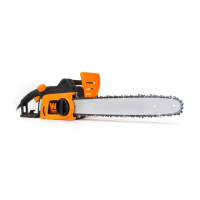13
OPERATION
PREVENTING KICKBACK
The term kickback refers to when the saw suddenly jumps up and back. This is usually caused by the workpiece
coming into contact with the guide bar tip or the clamping of the saw chain.
A kickback generates an abrupt powerful force. The saw usually reacts in an uncontrolled manner, creating the pos-
sibility of injury to the user.
The danger of a kickback is greatest when attempting to cut near or with the guide bar tip. Always apply the saw as
flatly as possible in order avoid a loss of control during operation.
OPERATION
TEST THE KICKBACK BRAKE (FIG. 9)
The kickback brake is a safety mechanism that is activated by the front
hand guard. The chain should stop immediately when kickback occurs.
The kickback brake function should be tested before each use.
To test the kickback brake:
1. Push the front hand guard forward and try to start the chain. The
chain should not start. If the chain does start, the brake is not working
and must be repaired.
2. Release the ON / OFF switch. To deactivate the kickback brake, pull
the hand guard backwards. The chain should now start when the ON /
OFF switch is pressed. The chain should also stop immediately when the
hand guard is pushed forward while the chain is running.
WARNING: Do not rely on the kickback brake to reduce the possibility of
injury due to kickback. Read prevention instructions above and on page
5 of this manual.
ON/OFF SWITCH (FIG. 10)
To turn the tool ON: Press the safety button (Fig. 10 - 1) and then squeeze
the trigger (Fig. 10 - 2). After the tool has started, you can release the
safety switch without turning the tool off.
To turn the tool OFF: Release the trigger switch (Fig. 10 - 2).
Brake in Use
Deactivate Brake
WARNING! Do not cut down trees in high wind conditions. This can result in injury and should only be per-
formed by a trained professional.
Fig. 9
Fig. 10
1
2

